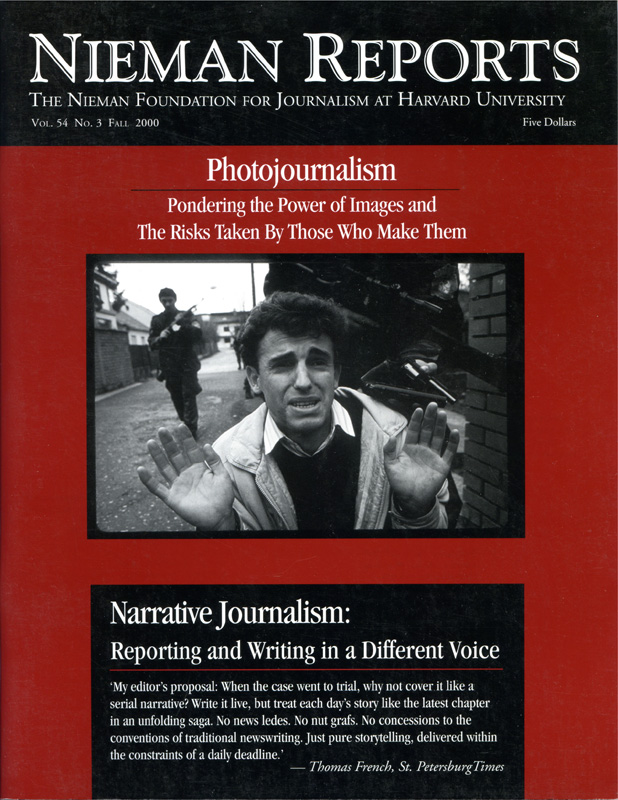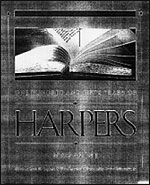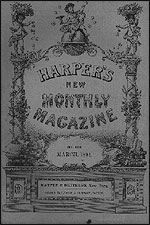The crowded racks on newsstands and the torrent of junk mail deliveries seeking subscribers testify to the superabundance of magazines being published in the United States. Some are even worth reading. The relative “old-timers” are a few decades old; some are mere infants facing high mortality rates. The journalistic landscape is littered with the bones of thousands of others, among them the esteemed monthlies Century, Scribners and McClure’s, all long gone, and such once prosperous latecomers as Life, The Saturday Evening Post, Look and Colliers. How long before Time, Newsweek and U.S. News & World Report drown in the cyberspace sea?
There are, though, two tough-skinned survivors whose history dates back to before the Civil War. They are Harper’s Magazine, which was launched in 1850, and The Atlantic Monthly, born in 1856. So this is Harper’s 150th birthday year, a time for toasts and celebration. Without waiting for the rest of us to raise a glass, Harper’s has done so itself, with a fat and handsome volume, an impressive taster’s menu for each of the 15 decades the magazine has been nourishing people who care about good prose and intellectual protein—a devoted but, alas, small crowd.
A stylish and lively, if sometimes polemical, introduction by Lewis Lapham sets the table for the album’s feast. Lapham was Harper’s editor from 1975 to 1981, one of four editors during a turbulent few years in the magazine’s history. He returned to the job in 1983 to restructure the magazine and pilot it into the 21st century. He and his collaborator Ellen Rosenbush must have labored long into the night to extract some 140 articles, short stories, and poems from 1,800 issues of Harper’s and tailor them for this collection. Those who pick and choose among the pieces in “An American Album” (it is too heavy to be read in long sittings) should be grateful for their efforts.
After I became editor of The Atlantic in the 1960’s I was struck by the number of people who confused The Atlantic with Harper’s and vice versa. When confronted with this confusion by a reader, or when traveling on the road to seek writers for the magazine I resorted, with a smile, to a paraphrase of Mark Twain’s remark: “Rudyard Kipling and I share all human knowledge. Kipling knows all there is to be known and I know all the rest.” The Atlantic of course was Kipling. Willie Morris was then editing Harper’s. We were competitors but also friends, so lest he be offended I dropped Willie a note saying that I wouldn’t be offended if he used the same quote and reversed the names.
Reading this volume, or just its table of contents, one can understand why the confusion persisted. From their beginnings until the mid-1980’s the magazines’ content was remarkably similar, Harper’s a bit more political perhaps, while The Atlantic listed more to the literary. They shared many authors—Melville, Hawthorne, Twain and Henry James, to name a few in the early days; Walter Lippmann, James Thurber, Katherine Anne Porter, John Kenneth Galbraith, James Dickey, John Updike in more recent years. The Atlantic’s first editor, James Russell Lowell, later became a Harper’s contributor. William Dean Howells went from being editor of The Atlantic in Boston to author of Harper’s famed Easy Chair column in New York. For many years after World War II, the magazines sold their advertising through a jointly owned company, Harper-Atlantic Sales. Readership overlapped by less than 10 percent, offering advertisers twice the package that the magazines could provide individually.
For all this seeming incest, the two magazines were always intense if friendly competitors, reaching out for the same kind of readers, trying to snare the best among recognized writers and discover the finest new talent, each editor rejoicing at his journalistic coup and envying the other’s.
Survival has not been easy. The coming of television and the takeover of Madison Avenue by young people who didn’t read plus rising postal and paper costs decimated the mass circulation publications. The two monthlies held on because their owners expected little or no profit and they had to produce only a few hundred thousand instead of millions of magazines. In the 1970’s, after it had fallen into the incompetent hands of John Cowles, Jr., of the Minneapolis Star-Tribune, Cowles and Editor Morris made the mistake of investing virtually all of his editorial budget in a handful of name writers (e.g. David Halberstam, Norman Mailer, the Texan Larry King). Harper’s Magazine went into a serious decline. While critical of Cowles’ publishing decisions, Lapham in his introduction lays much of the blame on Willie Morris and his small coterie of writers.
The new publishing strategy, Lapham writes, “matched the go-go expectations of the Age of Aquarius, and for two or three years it seemed to hold out the promise of astonishing success. Morris published Mailer’s dispatches from the riots in Miami and Chicago, the literary criticism of Alfred Kazin and Irving Howe, Halberstam’s excoriation of the deluded government officials…mismanaging the war in Vietnam. The magazine was much talked about in New York, proclaimed a wonder of the age on the Upper East Side. Elsewhere the reviews were not so kind. West of the Hudson River subscribers departed in droves, the advertising revenues declined, most of the newsstand copies were being shredded or returned. The poor result reflected the several degrees of separation in the nation’s attitude toward the Vietnam War, drugs, radical college students, black power, free-form feminists, and long hair.” This is an overly harsh criticism, in my estimation, but an accurate description of what happened to the magazine’s readership.
By the end of 1970 the magazine’s annual loss had soared to $700,000 and circulation had fallen to well below 300,000. Blaming each other for the decline, Morris resigned and Cowles accepted. Then came about a dozen years of drift and a parade of editors. By 1980 the loss was close to $2,000,000 and the situation was so parlous that “the owners declared the magazine extinct.” Just in time came the blare of the U.S. Cavalry bugle: The MacArthur Foundation in Chicago agreed to save the magazine. John R. MacArthur, a bright, energetic grandson of the foundation’s founder, instituted the recovery operation and stepped in himself to become the publisher and remains so today. He brought Lew Lapham back to reconstitute the magazine as the smaller, deliberately lower circulation, nonprofit journal it is today, with a slim staff and relying less on commissioned articles and in-depth reporting than the old Harper’s. Its circulation is about 217,000 and, says Lapham, it “is now sustained by its own advertising and subscription revenues.” His invention of the monthly Harper’s Index of obscure and often startling facts and figures has proved to be more addictive to many readers than nicotine, without any of the poison.
No longer is there reason to confuse the new Harper’s with The Atlantic. The latter continues to be the kind of magazine it has always been, originating its own material and offering journalism in depth (though not so interminably as William Shawn’s New Yorker) across the broad spectrum of literature, culture, science and public affairs. It suffered its own problems during the rude 1970’s as it became more expensive to attain subscribers and deliver magazines and to compete with far wealthier publications for articles and short stories. Seeking a much-needed infusion of cash to finance the magazine’s ambitions, the company sold to the real-estate operator Mortimer Zuckerman. The results were unpleasant for me and for some of my associates but good for the magazine’s future.
Zuckerman hired a good replacement as editor, plowed money into the product, beefed up the staff and salaries. If he hadn’t gone on an ego trip to waste perhaps millions on inflating the circulation of the magazine he might have moved it toward solid if limited profitability. The magazine’s claimed circulation of more than 460,000 was grossly diluted by cut-rate subscriptions. Known as a real whiz in the real estate business, Zuckerman proved to be an inferior publisher. He let the business side and the advertising sales force deteriorate. He capitulated last year, selling to a new publisher who seems to know what he is doing and a new editor who seems determined to keep The Atlantic Monthly’s flag flying proudly.
So here’s a toast to both those hardy survivors: Long may they continue.
Robert Manning, a 1946 Nieman Fellow, was the editor of The Atlantic Monthly from 1964 until 1980. Prior to that he was Assistant Secretary of State for Public Affairs during the Kennedy administration, a senior editor and foreign correspondent for Time, and United Nations bureau chief for the United Press.
There are, though, two tough-skinned survivors whose history dates back to before the Civil War. They are Harper’s Magazine, which was launched in 1850, and The Atlantic Monthly, born in 1856. So this is Harper’s 150th birthday year, a time for toasts and celebration. Without waiting for the rest of us to raise a glass, Harper’s has done so itself, with a fat and handsome volume, an impressive taster’s menu for each of the 15 decades the magazine has been nourishing people who care about good prose and intellectual protein—a devoted but, alas, small crowd.
A stylish and lively, if sometimes polemical, introduction by Lewis Lapham sets the table for the album’s feast. Lapham was Harper’s editor from 1975 to 1981, one of four editors during a turbulent few years in the magazine’s history. He returned to the job in 1983 to restructure the magazine and pilot it into the 21st century. He and his collaborator Ellen Rosenbush must have labored long into the night to extract some 140 articles, short stories, and poems from 1,800 issues of Harper’s and tailor them for this collection. Those who pick and choose among the pieces in “An American Album” (it is too heavy to be read in long sittings) should be grateful for their efforts.
After I became editor of The Atlantic in the 1960’s I was struck by the number of people who confused The Atlantic with Harper’s and vice versa. When confronted with this confusion by a reader, or when traveling on the road to seek writers for the magazine I resorted, with a smile, to a paraphrase of Mark Twain’s remark: “Rudyard Kipling and I share all human knowledge. Kipling knows all there is to be known and I know all the rest.” The Atlantic of course was Kipling. Willie Morris was then editing Harper’s. We were competitors but also friends, so lest he be offended I dropped Willie a note saying that I wouldn’t be offended if he used the same quote and reversed the names.
Reading this volume, or just its table of contents, one can understand why the confusion persisted. From their beginnings until the mid-1980’s the magazines’ content was remarkably similar, Harper’s a bit more political perhaps, while The Atlantic listed more to the literary. They shared many authors—Melville, Hawthorne, Twain and Henry James, to name a few in the early days; Walter Lippmann, James Thurber, Katherine Anne Porter, John Kenneth Galbraith, James Dickey, John Updike in more recent years. The Atlantic’s first editor, James Russell Lowell, later became a Harper’s contributor. William Dean Howells went from being editor of The Atlantic in Boston to author of Harper’s famed Easy Chair column in New York. For many years after World War II, the magazines sold their advertising through a jointly owned company, Harper-Atlantic Sales. Readership overlapped by less than 10 percent, offering advertisers twice the package that the magazines could provide individually.
For all this seeming incest, the two magazines were always intense if friendly competitors, reaching out for the same kind of readers, trying to snare the best among recognized writers and discover the finest new talent, each editor rejoicing at his journalistic coup and envying the other’s.
Survival has not been easy. The coming of television and the takeover of Madison Avenue by young people who didn’t read plus rising postal and paper costs decimated the mass circulation publications. The two monthlies held on because their owners expected little or no profit and they had to produce only a few hundred thousand instead of millions of magazines. In the 1970’s, after it had fallen into the incompetent hands of John Cowles, Jr., of the Minneapolis Star-Tribune, Cowles and Editor Morris made the mistake of investing virtually all of his editorial budget in a handful of name writers (e.g. David Halberstam, Norman Mailer, the Texan Larry King). Harper’s Magazine went into a serious decline. While critical of Cowles’ publishing decisions, Lapham in his introduction lays much of the blame on Willie Morris and his small coterie of writers.
The new publishing strategy, Lapham writes, “matched the go-go expectations of the Age of Aquarius, and for two or three years it seemed to hold out the promise of astonishing success. Morris published Mailer’s dispatches from the riots in Miami and Chicago, the literary criticism of Alfred Kazin and Irving Howe, Halberstam’s excoriation of the deluded government officials…mismanaging the war in Vietnam. The magazine was much talked about in New York, proclaimed a wonder of the age on the Upper East Side. Elsewhere the reviews were not so kind. West of the Hudson River subscribers departed in droves, the advertising revenues declined, most of the newsstand copies were being shredded or returned. The poor result reflected the several degrees of separation in the nation’s attitude toward the Vietnam War, drugs, radical college students, black power, free-form feminists, and long hair.” This is an overly harsh criticism, in my estimation, but an accurate description of what happened to the magazine’s readership.
By the end of 1970 the magazine’s annual loss had soared to $700,000 and circulation had fallen to well below 300,000. Blaming each other for the decline, Morris resigned and Cowles accepted. Then came about a dozen years of drift and a parade of editors. By 1980 the loss was close to $2,000,000 and the situation was so parlous that “the owners declared the magazine extinct.” Just in time came the blare of the U.S. Cavalry bugle: The MacArthur Foundation in Chicago agreed to save the magazine. John R. MacArthur, a bright, energetic grandson of the foundation’s founder, instituted the recovery operation and stepped in himself to become the publisher and remains so today. He brought Lew Lapham back to reconstitute the magazine as the smaller, deliberately lower circulation, nonprofit journal it is today, with a slim staff and relying less on commissioned articles and in-depth reporting than the old Harper’s. Its circulation is about 217,000 and, says Lapham, it “is now sustained by its own advertising and subscription revenues.” His invention of the monthly Harper’s Index of obscure and often startling facts and figures has proved to be more addictive to many readers than nicotine, without any of the poison.
No longer is there reason to confuse the new Harper’s with The Atlantic. The latter continues to be the kind of magazine it has always been, originating its own material and offering journalism in depth (though not so interminably as William Shawn’s New Yorker) across the broad spectrum of literature, culture, science and public affairs. It suffered its own problems during the rude 1970’s as it became more expensive to attain subscribers and deliver magazines and to compete with far wealthier publications for articles and short stories. Seeking a much-needed infusion of cash to finance the magazine’s ambitions, the company sold to the real-estate operator Mortimer Zuckerman. The results were unpleasant for me and for some of my associates but good for the magazine’s future.
Zuckerman hired a good replacement as editor, plowed money into the product, beefed up the staff and salaries. If he hadn’t gone on an ego trip to waste perhaps millions on inflating the circulation of the magazine he might have moved it toward solid if limited profitability. The magazine’s claimed circulation of more than 460,000 was grossly diluted by cut-rate subscriptions. Known as a real whiz in the real estate business, Zuckerman proved to be an inferior publisher. He let the business side and the advertising sales force deteriorate. He capitulated last year, selling to a new publisher who seems to know what he is doing and a new editor who seems determined to keep The Atlantic Monthly’s flag flying proudly.
So here’s a toast to both those hardy survivors: Long may they continue.
Robert Manning, a 1946 Nieman Fellow, was the editor of The Atlantic Monthly from 1964 until 1980. Prior to that he was Assistant Secretary of State for Public Affairs during the Kennedy administration, a senior editor and foreign correspondent for Time, and United Nations bureau chief for the United Press.





